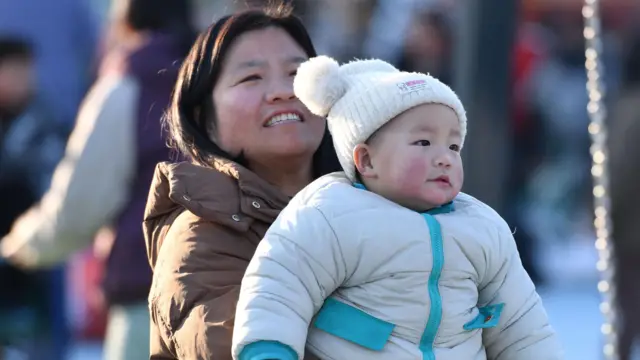
China’s state-run Global Times on Monday reported that 25 provincial authorities are set to begin distributing “maternity allowances” to women on November 1.
In other words, having exhausted every other strategy to combat demographic decline, China will start paying women to have babies.
“Since September, provinces such as Jiangxi, Anhui and Shaanxi have successively rolled out direct payments of maternity allowances to individuals province-wide,” the Global Times noted.
The expanded program scheduled to roll out on November 1 will cover “nearly 90 percent of all social insurance pooling areas of the country.” A few notable exceptions include Beijing, the tech hub of Guangdong, and the Xinjiang Uyghur Autonomous Region (XUAR).
China’s National Healthcare Security Administration (NHSA) said the direct subsidies for childbirth, intended to cover “living expenses paid to female employees during maternity leave,” would bring China one step closer to becoming a “childbirth-friendly society.”
China has already implemented several programs to reduce the cost of maternity and child-rearing, but until now, the subsidies were generally paid to employers rather than directly distributed to the beneficiaries.
Demography experts told the Global Times that routing the subsidies through employers invited “deductions, delays or misuse,” including employers deciding to keep some of the subsidy money to offset the cost of paid maternity leave. Also, using employers to distribute the subsidies raised the apparent cost of hiring female employees, and the indirect system did little to benefit “flexible workers” such as ride-hailing drivers, food delivery workers, and freelancers.

On the other hand, some of the direct subsidy money will only be available to women who paid money into the system through paycheck deductions – in fact, the NHSA is boasting that little paperwork is required to claim benefits beyond proof that the recipient made payments to finance the system – and the subsidies “remain relatively low compared with the costs of childbirth, childcare, and education.”
Louise Loo, head of Asia research for Oxford Economics, glumly noted to the Washington Post on October 11 that it is “almost impossible to reverse a demographic decline,” even for an authoritarian regime like China with fairly deep pockets.

China’s brutal “One Child Policy” of population control left the next generation short of fertile women, since couples wanted boys more than girls. The Chinese Communist regime seemed surprised that it could not simply order its population to start having more children when demographic decline became apparent. Numerous big-money programs to increase fertility have failed to produce adequate results, as in other declining countries that attempted similar programs, like Japan and South Korea.
“The Chinese government is now throwing money at the problem, but it may come as too little, too late. Last month, Beijing unveiled a new subsidy of about $500 a year for the first three years of a child’s life. On social media, some commentators noted they would consider having more children if the subsidy were 10 times what’s being offered,” the Washington Post noted.
Fewer children, coupled with longer lifespans and higher costs for supporting retirees, is creating a demographic crisis in almost every industrialized nation, but China’s hangover from the One Child Policy is making it worse. Loo’s calculations said China could lose half a percent from its GDP growth over the coming decade due to population decline.
BEIJING FACES DEEPENING DEMOGRAPHIC CRISIS AS MARRIAGE RATE HITS DECADES-LOW

Marriage Meltdown Signals Trouble for China’s Birth Rate
BEIJING — China’s ongoing demographic crisis has intensified, with the national marriage rate plummeting to its lowest level since 1980. This drastic decline in young people tying the knot is fueling fears that the government’s efforts to boost the nation’s falling birth rate are failing, posing a severe threat to China’s long-term economic stability.
According to data released by the Ministry of Civil Affairs, only 6.1 million couples registered for marriage in 2024, a massive 20.5% drop from the previous year’s figure of 7.68 million. This downturn returns the marriage rate to its decade-long downward trajectory, interrupted only temporarily by a minor rebound in 2023 following the end of COVID-19 lockdowns.
Demographers widely view the marriage rate as a leading indicator for future births, as the vast majority of children in China are born within wedlock. The sharp drop in new marriages in 2024 is now expected to push the birth rate even lower in 2025, intensifying a population decline that began in 2022.

Economic Stress and Changing Values Drive Shift
The reluctance of young Chinese adults to marry and have children is rooted in a convergence of social and economic pressures:
- Skyrocketing Costs: High youth unemployment, rising costs of living, and the prohibitive expense of childcare and education in major urban areas make starting a family financially daunting.
- Shifting Priorities: A growing number of women, particularly those with higher education, are delaying marriage or choosing to remain single, prioritizing their careers and personal autonomy over traditional family roles. The average age for first-time marriage and first-time childbirth continues to climb in cities like Shanghai.
- Gender Imbalance: Decades of the “one-child policy” have led to a significant gender imbalance, leaving millions of men unable to find a partner, a crisis exacerbated by the tradition of high “bride prices” in some regions.
Dr. Yi Fuxian, a demographer at the University of Wisconsin-Madison, noted that the number of marriages in 2024 is less than half the peak of 13.47 million seen in 2013, calling the trend “unprecedented.”
Policy Incentives Fail to Resonate
Despite the alarming statistics, the government’s attempts to encourage family formation have yielded limited results. Beijing has rolled out numerous pro-natal policies, including relaxing the one-child policy to allow up to three children, offering financial incentives, and even urging universities to promote “love education.”
While 2024 saw a slight, temporary uptick in the birth rate (attributable to the clearing of the post-pandemic backlog and the auspicious Chinese Zodiac Year of the Dragon), experts agree the fundamental demographic headwinds are too strong to be reversed by mere incentives.
As the population continues to age rapidly—with roughly 300 million Chinese expected to enter retirement within the next decade—the declining pool of young workers and consumers threatens to significantly drag down China’s potential economic growth, a grim challenge for the nation’s leadership.






:max_bytes(150000):strip_icc():focal(774x396:776x398)/baby-found-toilet-cistern-111825-1-d9150426c69243f4a1778eb518589c20.jpg?w=1200&resize=1200,0&ssl=1)


















:max_bytes(150000):strip_icc():focal(728x320:730x322):format(webp)/Dougherty-Dozen-121925-8cb8e5c784f24afa8d04fbffee3fef7d.jpg?w=1200&resize=1200,0&ssl=1)











:max_bytes(150000):strip_icc():focal(749x0:751x2):format(webp)/Christianna-Apps-5-121825-ae06cb988405460987109364d7c522c3.jpg?w=1200&resize=1200,0&ssl=1)
:max_bytes(150000):strip_icc():focal(749x0:751x2):format(webp)/Mary-B-Premature-Baby-121925-8be6c0dca6784de0879dbeab3aab0038.jpg?w=1200&resize=1200,0&ssl=1)

:max_bytes(150000):strip_icc():focal(742x400:744x402)/Pierce-Brosnan-MobLand-New-York-Premiere-081625-8199483881a0468894490be96e3cbf8b.jpg?w=1200&resize=1200,0&ssl=1)


